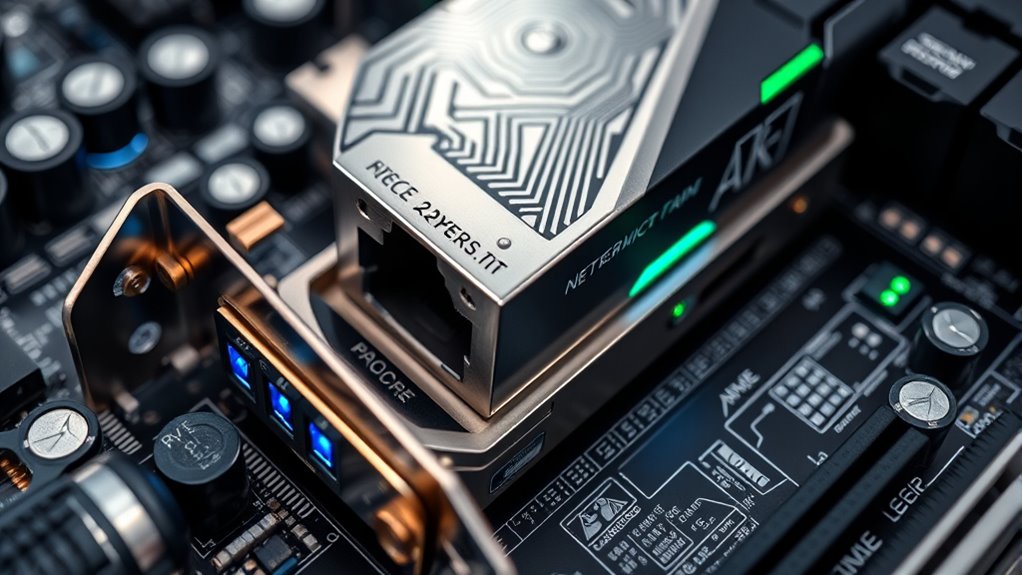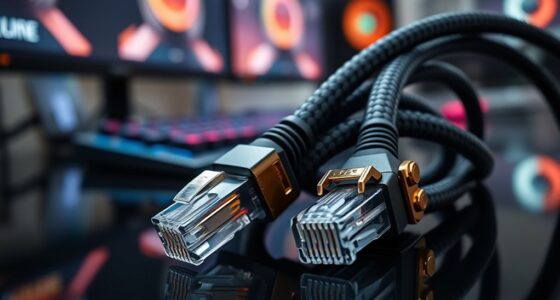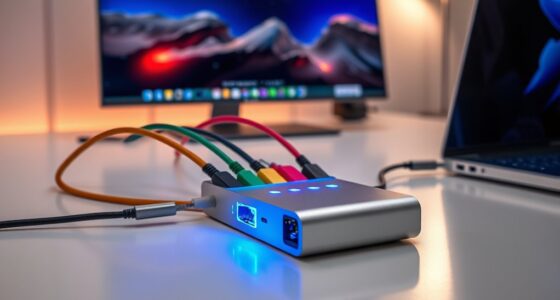If you’re searching for the best PCIe 10 Gb NICs of 2025, I’ve got you covered. I’ve reviewed top models like the TP-Link TX401, 10Gtek, and GLOTRENDS, focusing on performance and reliability. These cards support multi-gigabit speeds, advanced features, and broad compatibility, making them perfect for demanding environments. Keep exploring, and you’ll find detailed insights on each option to help you make an informed decision.
Key Takeaways
- Top PCIe 10Gb NICs in 2025 offer high-speed, stable performance suitable for servers, NAS, and high-demand networking environments.
- Compatibility spans Windows, Linux, VMware, and enterprise systems, with some models supporting advanced features like VLAN, QoS, and MACsec.
- Many options feature robust construction, cooling solutions, and versatile bracket options for reliable, long-term operation.
- Performance reviews highlight near 10Gbps speeds with low latency, ideal for streaming, large transfers, and enterprise workloads.
- Consider warranty, support, and value when choosing, with premium models providing extended coverage and advanced management tools.
TP-Link 10GB PCIe Network Card (TX401)
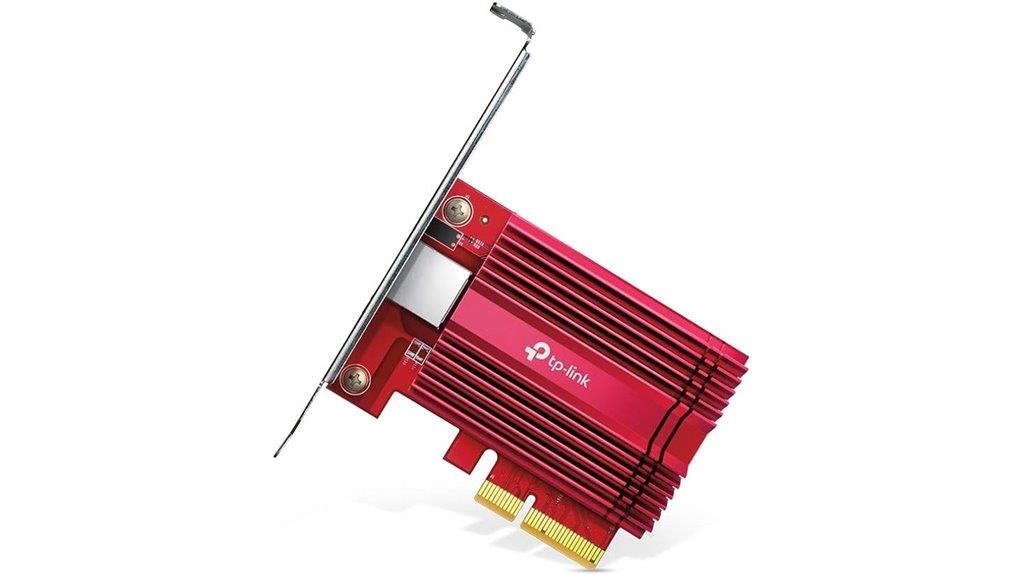
If you’re looking for a reliable, high-performance PCIe 10 Gb NIC that’s easy to install and compatible with various systems, the TP-Link TX401 is an excellent choice. I found this card supports 10Gbps Ethernet via PCIe 3.0, making it perfect for fast data transfers, streaming, and gaming. It auto-negotiates across multiple speeds, ensuring smooth upgrades. The included CAT6A cable and versatile brackets make installation straightforward in different cases. Compatible with Windows, Linux, and servers, it offers stable, full-speed connections and a low power footprint. Overall, the TX401 delivers excellent value, reliability, and effortless setup for demanding bandwidth needs.
Best For: users seeking a high-speed, reliable, and easy-to-install 10Gbps Ethernet solution for gaming, data transfer, or network upgrades across Windows, Linux, or server environments.
Pros:
- Supports 10Gbps Ethernet with auto-negotiation across multiple speeds for flexible upgrades
- Compatible with a wide range of operating systems including Windows and Linux, with plug-and-play support
- Comes with versatile brackets and a high-quality CAT6A cable for straightforward installation and optimal performance
Cons:
- Achieving maximum advertised speeds may require proper cabling and system configuration
- Driver updates or compatibility issues could arise on older hardware or certain Linux distributions
- Slightly higher cost compared to standard Gigabit network cards, which may be a consideration for budget-conscious users
10Gtek 10Gb PCIe NIC Network Card with SFP+ Port
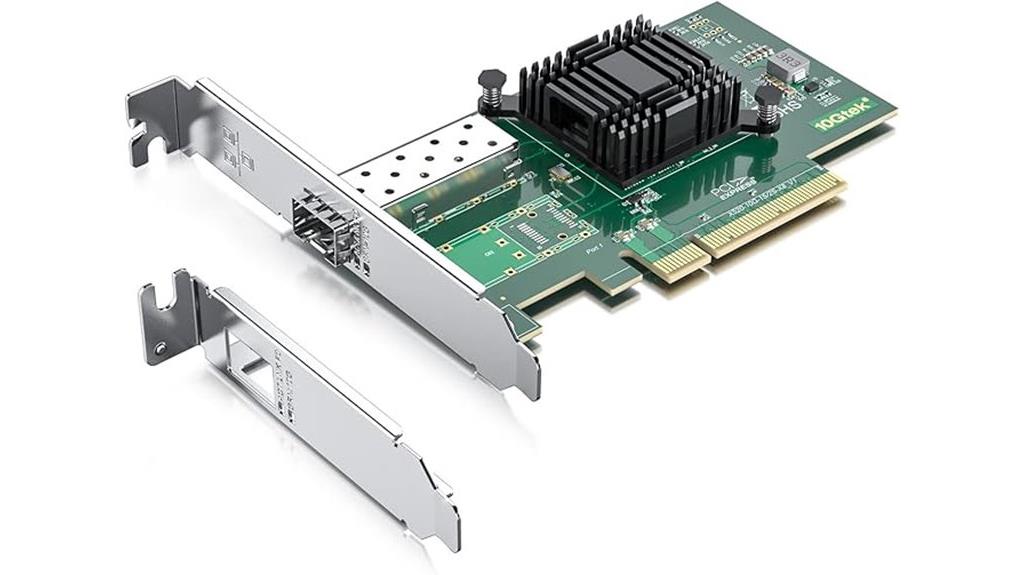
The Gtek 10Gb PCIe NIC Network Card with SFP+ Port stands out as an excellent choice for those seeking a reliable, high-speed network interface in data centers, NAS setups, or enterprise environments. Equipped with an Intel 82599EN controller, it supports only 10G speeds and is compatible with Windows Server, Linux, VMware, and ESX/ESXi, though Windows 11 drivers may require manual setup. Designed for PCIe x8 and x16 slots, it includes both profile and low-profile brackets, making it versatile for different cases. While not hot-swappable, it delivers stable, high-throughput connections ideal for demanding data transfers, virtualization, and network storage.
Best For: professionals and organizations needing a high-speed, reliable 10G network interface for data centers, virtualization, or network storage solutions.
Pros:
- Supports ultra-fast 10G speeds with stable performance and minimal latency.
- Compatible with multiple operating systems including Windows Server, Linux, VMware, and ESX/ESXi.
- Includes both profile and low-profile brackets for versatile installation in various cases.
Cons:
- Driver installation may require manual setup, especially for Windows 11 and Linux.
- Not hot-swappable; requires system shutdown before installation or removal.
- Compatibility issues may arise with certain NAS devices or specific hardware configurations.
10G PCIe Network Card with Marvell AQC113 Controller

Designed for users demanding high-speed, reliable connectivity, the G PCIe Network Card with Marvell AQC113 Controller offers a robust solution for gaming, streaming, and data-intensive tasks. It features the Marvell AQC113 chipset and PCIe 4.0 x1 interface, supporting speeds from 1G to 10G over RJ45 connectors. Compatible with various PCIe slots, it fits desktops, workstations, and servers. The card includes full-height and low-profile brackets, ensuring flexible installation. Its durable design, with gold-plated connectors and solid capacitors, guarantees long-term stability. Easy to set up with plug & play, it also supports Wake-on-LAN for remote management, making it a versatile choice for demanding networks.
Best For: users seeking high-speed, reliable network connectivity for gaming, streaming, and data-intensive applications in desktops, workstations, or servers.
Pros:
- Supports a wide range of speeds from 1G to 10G over RJ45 connectors for versatile networking.
- Compatible with multiple PCIe slot types and both full-height and low-profile brackets for flexible installation.
- Durable design with gold-plated connectors and solid capacitors ensures long-term stability and performance.
Cons:
- Requires PCIe 4.0 x1 slot; may not be compatible with older systems lacking PCIe 4.0 support.
- Limited to RJ45 Ethernet connections, which may not suit users needing fiber or other interfaces.
- Basic plug & play setup may lack advanced configuration options for specialized network requirements.
H!Fiber 10Gb SFP+ PCIe Network Card with Broadcom BCM57810S
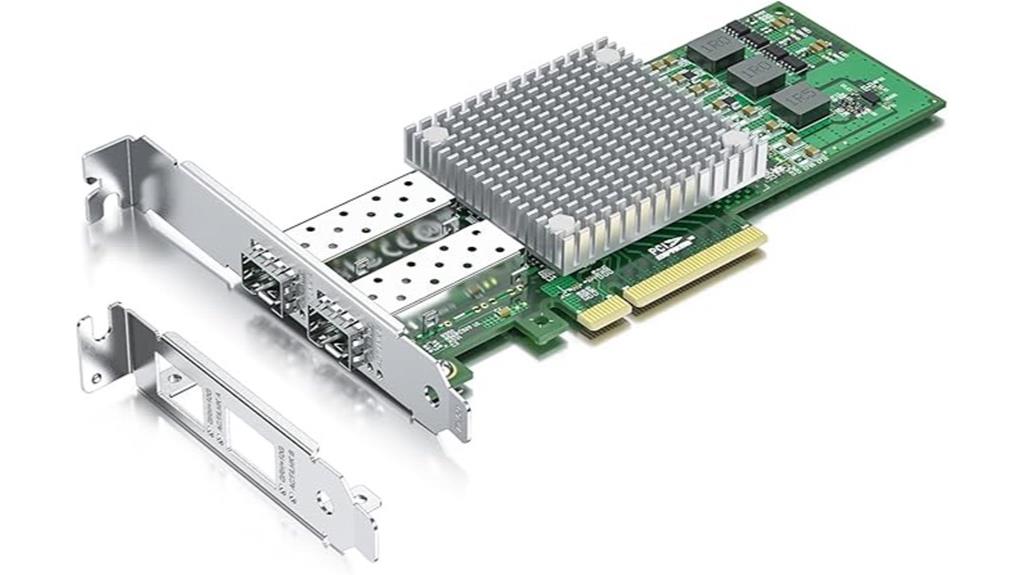
For those seeking a reliable and high-performance 10GbE network upgrade, the H!Fiber 10Gb SFP+ PCIe Network Card with Broadcom BCM57810S stands out thanks to its dual SFP+ ports supporting speeds up to 10 Gbps. It features the Broadcom BCM57810S controller with QoS technology, ensuring stable online performance. Compatible with PCIe X8 and X16 slots, it works seamlessly across Windows, Linux, FreeBSD, and virtualization platforms like VMware. Easy to install, often recognized immediately, and praised for stable throughput, it’s a cost-effective choice for enterprise servers, NAS, or firewall appliances aiming for high-speed connectivity.
Best For: professionals and businesses seeking a reliable, high-speed 10GbE network upgrade for servers, NAS devices, and virtualization environments.
Pros:
- Supports speeds up to 10 Gbps with compatible modules and transceivers.
- Easy plug-and-play installation with broad OS compatibility.
- Includes full-height and low-profile brackets for versatile deployment.
Cons:
- Some users report port failures or disconnections after prolonged use.
- Limited speed improvements above 3 Gbps in certain configurations.
- May require specific transceivers or cables to achieve maximum performance.
10G Base-T PCI-e Network Card with Marvell AQC113 Controller
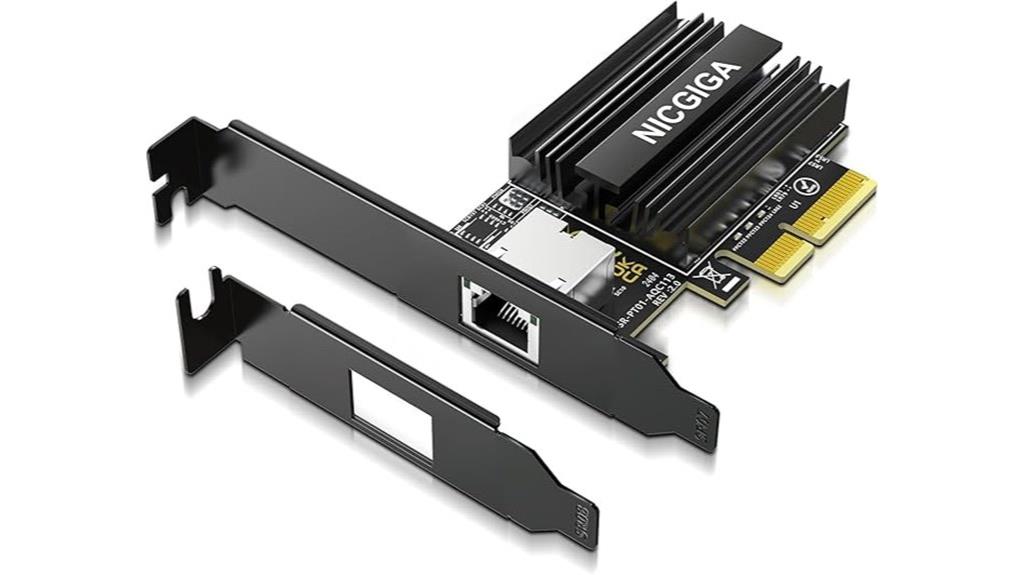
If you’re seeking a reliable and cost-effective upgrade for high-speed wired networking, the G Base-T PCI-e Network Card with Marvell AQC113 Controller is an excellent choice. It delivers up to 10 Gbps speeds, ensuring fast, stable connections with minimal packet loss. Compatible with Windows 10/11, Windows Server, and Linux, it’s easy to install in desktops, workstations, or servers, thanks to its standard and slim brackets. The card runs cool with heatsinks, providing consistent performance even during extended use. Users report near-full 10 Gbps throughput, stable operation, and excellent reliability, making it a solid upgrade for demanding network environments.
Best For: users seeking a reliable, high-speed wired networking upgrade for desktops, workstations, or servers requiring up to 10 Gbps connectivity.
Pros:
- Supports up to 10 Gbps speeds for fast, stable data transmission
- Compatible with Windows 10/11, Windows Server, and Linux for easy setup
- Runs cool with heatsinks, ensuring consistent performance during extended use
Cons:
- Lacks port trunking support under Windows 11 Home/Pro editions
- Some users experience driver installation or recognition issues initially
- No included port trunking or link aggregation features
10Gb PCIe NIC Network Card with Aquantia AQC107 Ethernet Controller

The Gb PCIe NIC Network Card with Aquantia AQC107 Ethernet Controller stands out as an excellent choice for users seeking high-speed, reliable wired connectivity in desktops, servers, or workstations. It features a single RJ45 port supporting multi-gigabit speeds up to 10Gbps, with auto-negotiation via NBASE-T technology. Compatible with Windows 10/11, Windows Server, and Linux kernels, it fits PCIe x4, x8, or x16 slots and includes versatile brackets for easy installation. Powered by the Aquantia AQC107 chipset, it guarantees stable, low-latency performance, supports Jumbo Frames, VLAN tagging, QoS, and energy efficiency, making it ideal for demanding network environments.
Best For: users seeking high-speed, reliable wired network connectivity for desktops, servers, or workstations requiring multi-gigabit performance.
Pros:
- Supports ultra-fast 10Gbps transfer speeds over a single RJ45 port with auto-negotiation.
- Compatible with Windows 11/10, Windows Server, and Linux kernels, ensuring broad usability.
- Includes versatile brackets for easy installation in various systems and supports advanced features like Jumbo Frames and VLAN tagging.
Cons:
- Requires a PCIe x4, x8, or x16 slot, which may not be available in all systems.
- Slightly larger dimensions may require careful installation in compact cases.
- User reviews indicate a learning curve for optimal configuration in certain network environments.
ipolex 10Gb Network Card Intel X540-T2 PCIe Ethernet Adapter
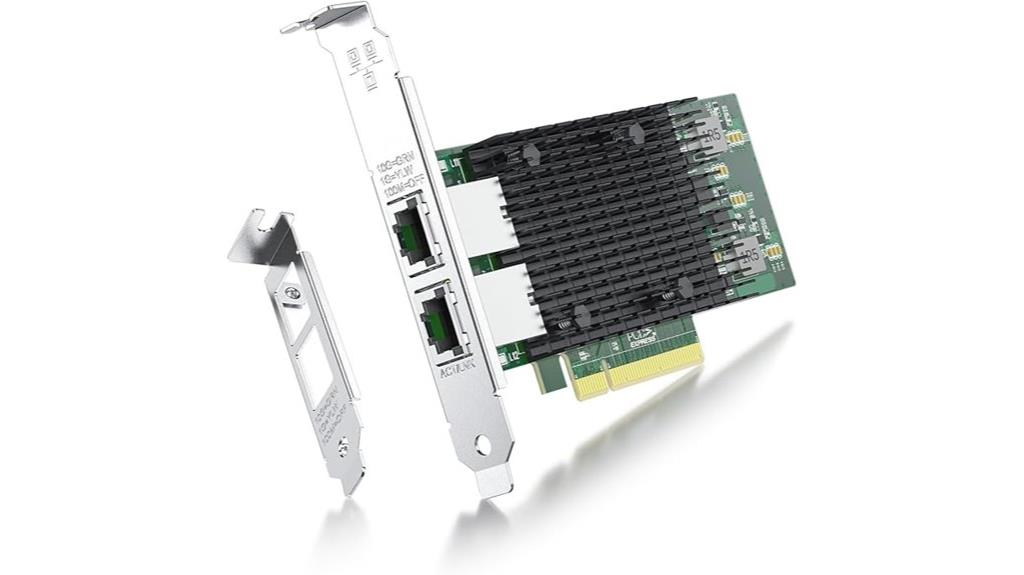
The ipolex 10Gb Network Card with the Intel X540-T2 controller stands out as an excellent choice for those building high-performance server or desktop systems requiring reliable 10Gbps Ethernet connections. It features dual RJ45 ports supporting 10Gbps and 1Gbps speeds, connects via an 8x PCIe slot, and is compatible with Windows Server, Linux, VMware, and FreeBSD. Installation is straightforward, though driver setup involves manual updates. The card delivers stable, high-speed performance ideal for data transfers, virtualization, and NAS setups. Proper cooling is essential due to heat generated by the X540 chipset, but overall, it offers great value, especially if you find a used or NOS unit.
Best For: users building high-performance servers, NAS systems, or desktops needing reliable 10Gbps network connectivity and virtualization support.
Pros:
- Supports stable 10Gbps/1Gbps speeds with dual RJ45 ports.
- Compatible with a wide range of operating systems including Windows, Linux, VMware, and FreeBSD.
- Robust design with heatsink and optional fan for thermal management under heavy workloads.
Cons:
- Discontinued and may only be available as NOS, limiting new purchases.
- Requires manual driver installation and potential troubleshooting for driver signing issues.
- Runs hot, with early fan failures reported; proper cooling solutions are necessary for long-term reliability.
ASUS XG-C100C 10G Network Adapter PCIe Card

Looking for a reliable 10Gbps Ethernet upgrade that’s easy to install and offers seamless compatibility? The ASUS XG-C100C is a PCIe x4 network adapter designed for high-speed data transfer. It features a single RJ-45 port and built-in QoS technology to prioritize bandwidth, ensuring smooth streaming, gaming, or large file transfers. Compatible with a wide range of OS including Windows 10/8.1/8/7 and Linux kernels, it supports current network standards from 1Gbps up to 10Gbps. Installation is straightforward, making it a top choice for upgrading desktop systems to ultra-fast networking without hassle.
Best For: users seeking a high-performance, easy-to-install 10Gbps Ethernet upgrade for desktop systems with broad OS compatibility.
Pros:
- Supports ultra-fast 10Gbps data transfer speeds ideal for bandwidth-intensive tasks.
- Compatible with multiple operating systems including Windows and Linux, ensuring flexible integration.
- Features built-in QoS technology to prioritize bandwidth and enhance online experiences.
Cons:
- Requires a PCIe x4 slot, which may not be available in all systems.
- Single RJ-45 port limits connection options to one device at a time.
- May involve additional setup for optimal configuration in complex network environments.
10G PCIe Network Card with 10Gbps Dual RJ45 Ports
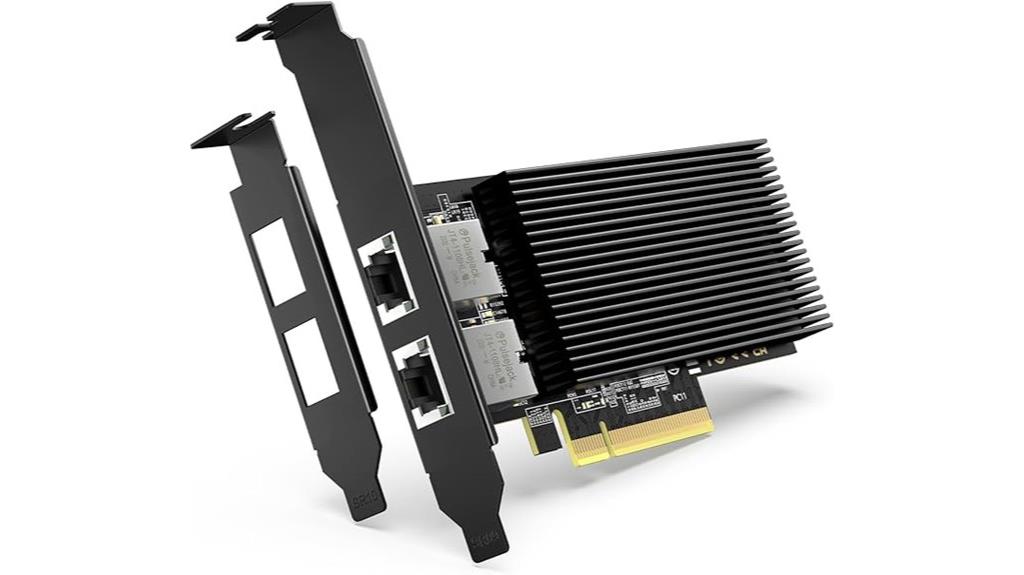
If you’re building a high-performance server or network setup that demands reliable, high-speed data transfer, the G PCIe Network Card with 10Gbps Dual RJ45 Ports is an excellent choice. It features dual 10Gbps copper ports powered by the Intel X540-T2 chipset, ensuring fast and stable connections. Compatible with Windows, Linux, VMware, and more, it fits into PCIe x8 and x16 slots, offering flexible installation. The card includes a heat sink for thermal management and a gold finger interface to minimize interruptions. With options for standard and slim brackets, it adapts easily to various server configurations, making it a versatile solution for demanding networks.
Best For: high-performance servers and enterprise networks requiring reliable, high-speed data transfer with versatile installation options.
Pros:
- Supports up to 10Gbps speeds with dual RJ45 ports for efficient data transmission
- Compatible with multiple operating systems including Windows, Linux, and VMware for flexible deployment
- Designed with thermal management features like a heat sink and a gold finger interface for stable operation
Cons:
- Requires PCIe x8 or x16 slots, which may not be available on all systems
- May need specific drivers or software setup for optimal performance across different OS environments
- Physical installation might be limited in compact or specialized server cases due to size or bracket options
10G Network Card with Intel X540 Chip, PCIe Ethernet Adapter
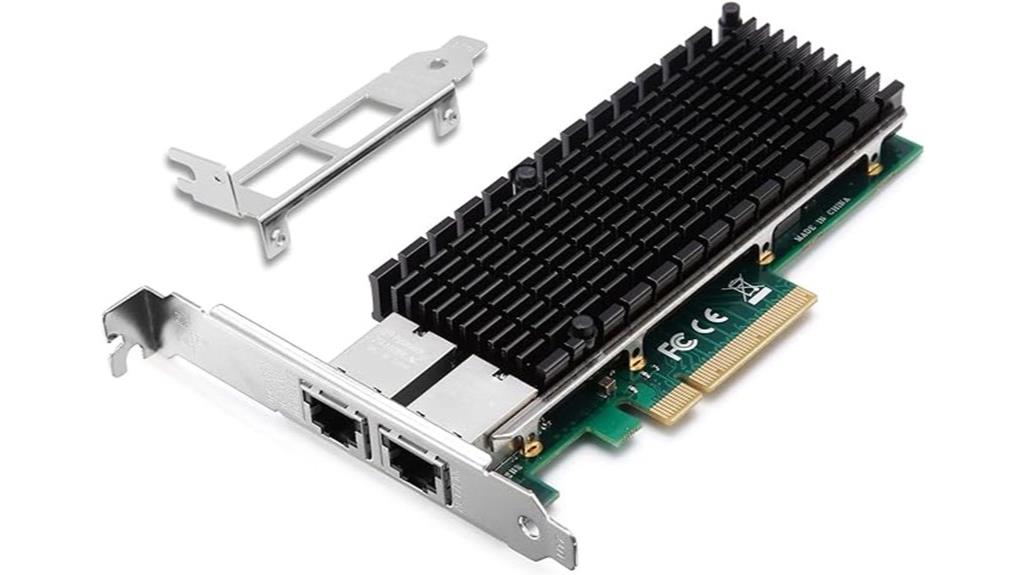
For enterprise environments demanding reliable, high-speed network connections, the G Network Card with Intel X540 Chip stands out as a top choice. It features dual RJ45 ports and supports speeds up to 10Gbps over a PCIe x8 interface, ensuring fast, stable connections. Compatible with Windows, Linux, VMware, and FreeBSD, it’s designed for versatile deployment. The card includes original Intel X540 controllers, offering intelligent offloads for enhanced stability during heavy workloads. Easy to install with full-height and low-profile brackets, it’s suitable for both servers and workstations. With extensive driver support and dedicated customer service, this NIC delivers impressive performance and reliability for demanding network environments.
Best For: enterprise IT professionals and data centers seeking reliable, high-speed network connectivity for servers and workstations.
Pros:
- Supports up to 10Gbps speeds with dual RJ45 ports for flexible high-speed connections
- Compatible with a wide range of operating systems including Windows, Linux, VMware, and FreeBSD
- Equipped with original Intel X540 controllers offering intelligent offloads for enhanced stability and performance
Cons:
- Requires PCIe x8 or x16 slots, which may not be available in all systems
- May need driver installation from the included CD or Intel website, adding to setup time
- Physical installation requires attention to case compatibility, especially for low-profile setups
10Gbe PCI-e Network Card with AQC113 Controller

The Gbe PCI-e Network Card with AQC113 Controller stands out as an ideal choice for professionals and organizations that require reliable, high-speed Ethernet connectivity. It offers up to 10 Gbps transmission speed, ensuring stable internet access and rapid local data transfers. The card easily converts PCIe slots (X4/X8/X16) into 10G RJ45 ports, supporting fiber optic connections across diverse systems like Windows, Linux, VMware, and servers. Installation is straightforward with standard or low-profile brackets, and driver setup is simplified via QR code. Its high-quality heatsink and gold-plated contacts guarantee thermal stability and hardware reliability, making it perfect for demanding network environments.
Best For: professionals and organizations seeking reliable, high-speed Ethernet connectivity for data centers, servers, or high-performance workstations.
Pros:
- Supports up to 10 Gbps transmission speed for fast data transfer and stable internet access
- Compatible with multiple systems including Windows, Linux, VMware, and servers, ensuring versatile deployment
- Easy installation with standard and low-profile brackets and simplified driver setup via QR code
Cons:
- Requires PCIe X4/X8/X16 slots, which may not be available on older or compact systems
- Limited to 10Gbps Ethernet connectivity, not suitable for lower-speed network environments
- Potential thermal management considerations if not properly ventilated, despite high-quality heatsink
GLOTRENDS 10Gb SFP+ Ethernet Network Card with Intel 82599EN
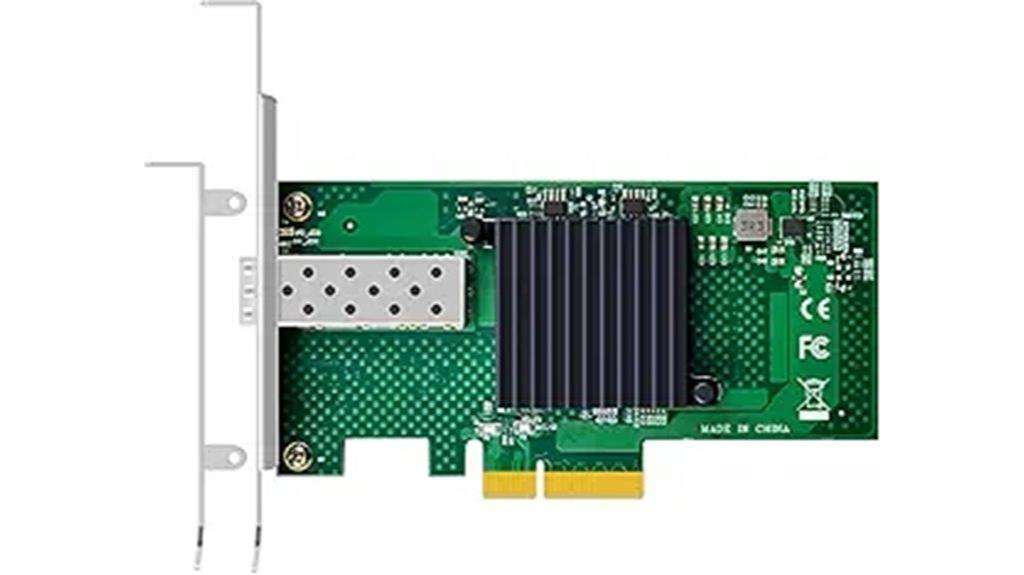
The GLOTRENDS 10Gb SFP+ Ethernet Network Card with Intel 82599EN is an excellent choice for professionals seeking reliable high-speed connectivity in enterprise or data center environments. It features the robust Intel 82599EN controller and a PCIe 2.0 X4 interface, supporting speeds up to 10Gbps with automatic negotiation for flexible network performance. Compatibility spans Windows, Linux, and FreeBSD, making it versatile for various systems. The card includes pre-installed brackets for different chassis types, though it requires an SFP+ module or cables separately. With advanced features like MACsec, VMDq, and PTP, it guarantees secure, low-latency, high-bandwidth network connections essential for demanding applications.
Best For: IT professionals and data center managers seeking high-speed, reliable network connectivity for enterprise or server environments.
Pros:
- Supports speeds up to 10Gbps with automatic negotiation for flexible performance
- Compatible with a wide range of operating systems including Windows, Linux, and FreeBSD
- Features advanced security and virtualization options like MACsec, VMDq, and PTP
Cons:
- Does not include SFP+ modules or cables, requiring additional purchase
- Not compatible with Mac OS systems
- Requires PCIe 2.0 X4 slot, which may limit compatibility with older hardware
TP-Link 2.5GB PCIe Network Card
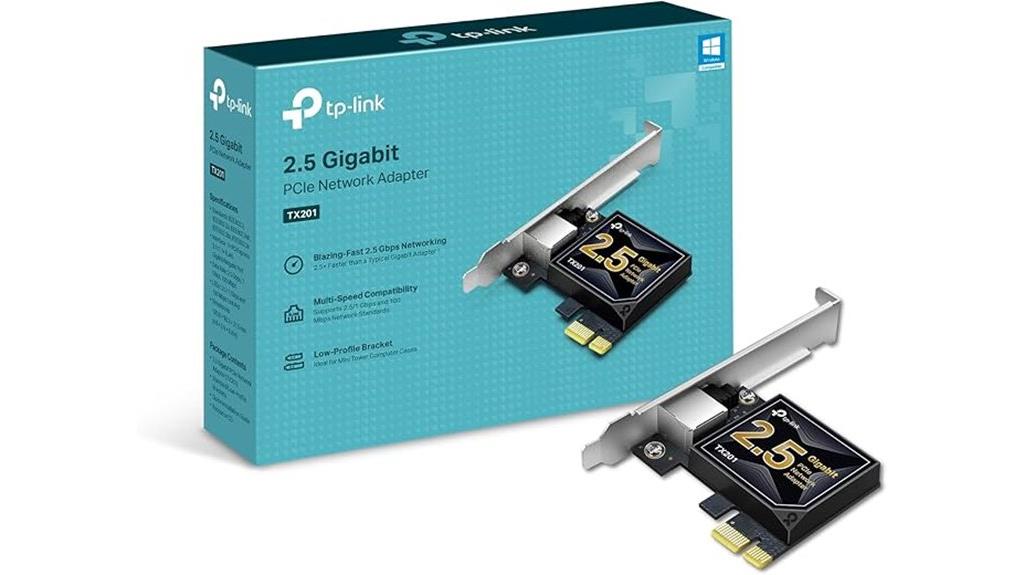
Looking to boost your network speeds without breaking the bank? The TP-Link TX201 is a 2.5Gbps PCIe network card that offers a significant upgrade over standard Gigabit Ethernet. It’s compatible with Windows 11, 10, and even Linux, making it versatile for many setups. The card automatically negotiates between 2.5 Gbps, 1 Gbps, and 100 Mbps, ensuring ideal performance. Installation is straightforward with plug-and-play support, and users praise its reliable connectivity and high-speed transfers. Rated 4.6 out of 5 stars, it’s a cost-effective solution for those seeking faster local and internet data transfer, especially when paired with compatible routers.
Best For: users seeking a budget-friendly, high-speed upgrade for their desktop or server network connection with easy installation and broad system compatibility.
Pros:
- Supports up to 2.5Gbps speeds for faster internet and local data transfers
- Compatible with Windows 11/10/8.1/8/7, Windows Server, and Linux for versatile use
- Plug-and-play design with reliable connectivity and solid build quality
Cons:
- May require driver updates or configuration adjustments on Windows for optimal performance
- Occasional issues with sleep mode reconnection reported by some users
- Full 2.5Gbps speeds depend on compatible routers and network equipment
Factors to Consider When Choosing Pcie 10 Gb NIC Review

When selecting a PCIe 10 Gb NIC, I focus on compatibility with my system and how well it performs at high speeds. I also consider how easy it is to install, along with the build quality and durability to guarantee long-term reliability. Finally, price, warranty, and overall value play a key role in making the right choice.
Compatibility With Systems
Ensuring compatibility with your system is crucial when selecting a PCIe 10 Gb NIC, as mismatched components can lead to performance issues or hardware conflicts. First, check that the NIC fits your motherboard’s PCIe slot type, whether x4, x8, or x16, to guarantee proper installation. Next, verify your operating system supports the NIC model with available drivers—this includes Windows, Linux, or VMware. Also, confirm that your system’s BIOS and firmware are up to date, as outdated firmware can cause compatibility problems. Additionally, make sure the NIC supports your network standards, such as 10GBase-T or SFP+, matching your existing infrastructure. Finally, consider the power and cooling requirements, guaranteeing your system can supply adequate power and airflow for stable operation.
Speed and Performance
Choosing the right PCIe 10 Gb NIC hinges heavily on its speed and overall performance. I look for a model that can consistently deliver close to 10 Gbps transfer rates under ideal conditions, ensuring maximum efficiency. Performance stability during sustained high-speed transfers is essential to prevent packet loss and keep my network reliable. Auto-negotiation features are valuable because they allow the NIC to adapt seamlessly to different network speeds, maintaining excellent performance. The quality of the chipset and controller directly affects throughput, latency, and the NIC’s capacity to handle multi-gigabit traffic without bottlenecks. Additionally, effective cooling solutions and solid hardware design help sustain high performance during prolonged data transfers, which is critical for demanding workloads. Overall, speed, stability, and quality are my top priorities.
Installation Complexity
Installing a PCIe 10 Gb NIC can vary in difficulty depending on several factors, so it’s important to contemplate these before making a purchase. Some models are plug-and-play, recognized automatically by modern operating systems, which simplifies installation. Others require manual driver downloads and configuration, adding complexity, especially on older or customized systems. Compatibility with your PCIe slot (x1, x4, x8, x16) also influences ease; mismatched slots may need hardware adjustments. Additionally, factors like cooling requirements, bracket modifications, and network setup can impact the installation process. If you’re looking for a straightforward setup, choosing a card with automatic recognition and broad compatibility makes a difference. Conversely, more advanced models might demand extra effort, so consider your technical comfort level before deciding.
Build Quality & Durability
When selecting a PCIe 10 Gb NIC, prioritizing build quality and durability is essential for long-term reliability. I look for models built with high-quality components like solid capacitors, sturdy PCB materials, and reinforced connectors, which guarantee longevity. Features such as heatsinks or active cooling help maintain ideal temperatures during heavy workloads, preventing overheating. It’s also important that the NIC includes both full-height and low-profile brackets to fit different cases. Reinforced ports and strain relief designs protect against cable tension and accidental impacts, reducing damage risks. Additionally, I consider the manufacturer’s warranty and build quality assurances, as these reflect confidence in the product’s durability and performance over time. Investing in a well-built NIC minimizes future issues and ensures consistent network reliability.
Price and Warranty
The price and warranty of a PCIe 10 Gb NIC play pivotal roles in determining its overall value and reliability. I recommend considering the warranty period, as longer warranties—like 2 or 3 years—offer better peace of mind and protection against defects. Price can vary greatly; budget models support 10Gbps but may lack advanced features, so assess whether the cost matches your performance needs. Higher-priced NICs often include extras like management tools, better cooling, or extended warranties, which can be worthwhile for enterprise use. Also, check if the warranty covers technical support and easy returns, ensuring dependable after-sales service. Keep in mind that some budget options might have limited warranty coverage, so compare terms carefully to avoid hidden costs or service restrictions.
Frequently Asked Questions
How Compatible Are These NICS With Different Operating Systems?
These NICs generally offer good compatibility across various operating systems like Windows, Linux, and macOS. I’ve found that most come with drivers or firmware updates that support different platforms, making integration smooth. However, it’s always best to double-check specific model compatibility and driver availability for your OS version. When in doubt, consulting manufacturer documentation or community forums can help guarantee seamless operation with your setup.
What Is the Typical Lifespan of a PCIE 10 Gb NIC?
Ever wonder how long your PCIe 10 Gb NIC will serve you? Typically, these cards last around 5 to 7 years with proper care, but it can be longer with quality components and good maintenance. I’ve seen some stay reliable even beyond that timeframe. Think of it like a durable tool—if you keep it clean and updated, it’ll keep performing well for years.
Do These NICS Support Link Aggregation and Teaming?
Yes, most PCIe 10 Gb NICs support link aggregation and teaming. I’ve found that modern models often include these features to boost performance and provide redundancy. They typically support standards like LACP, allowing me to combine multiple links for increased throughput or failover. It’s essential to check the specific model’s specifications, but generally, these NICs are designed with enterprise networking needs in mind, making them flexible for various setups.
How Do These NICS Perform Under Heavy Network Loads?
When it comes to heavy network loads, I find these NICs really shine, handling intense traffic smoothly. They maintain stable connections and don’t flinch under pressure, which is vital for demanding tasks. While some might find performance dips during peak times, I’ve been impressed with their resilience and reliability. If you need consistent, high-speed data transfer, these NICs are a solid choice that won’t let you down when it counts most.
Are Driver Updates Necessary for Optimal Performance?
Driver updates are definitely necessary for peak performance. I always guarantee my NIC drivers are current because updates often fix bugs, improve stability, and enhance compatibility with new network standards. Outdated drivers can cause slow speeds or connection drops, so I regularly check for updates from the manufacturer’s website. Staying current helps me get the most reliable, fastest performance out of my PCIe 10 Gb NICs.
Conclusion
If you’re hunting for the best PCIe 10Gb NICs of 2025, I’ve got you covered. From the dependable TP-Link to the robust GLOTRENDS, these cards offer a mix of speed and reliability that’s hard to beat. Think of it like choosing a trusty steed for the digital age—each one’s ready to carry your data swiftly across the network plains. With these options, you’ll be back in the fast lane in no time.
